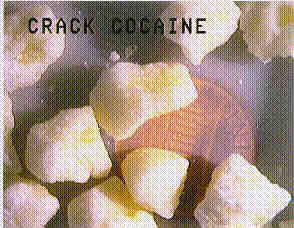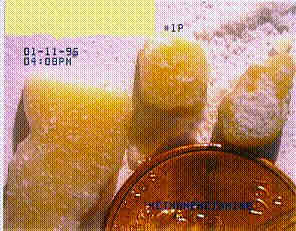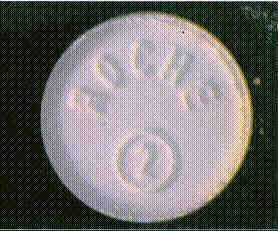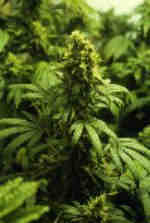

Cocaine as we see it on the street in our community comes from the leaves of the coca plants which grow in South America. After the drug is extracted from the leaves it is then transformed by a crude laboratory, usually in Columbia, into what is know as "Cocaine Hydrochloride" (Powder Cocaine). This is the watersoluble form of the drug extracted from the leaves. This "cocaine" appears as a white crystalline powder or white crystalline chunks depending on its purity and type of cutting agent used by the street dealer. "Crack" cocaine on the other hand has the same beginnings but when it comes into the hand of the street dealer it is broken down into a solid form which is smoked. "Crack" cocaine looks like a light brown or beige crystalline rock with almost the same consistency as soap or macadamia nuts. Cocaine is packaged in a variety of ways; folded papers called "bindles", small vials, zip lock baggies and Tupperware type containers. "Crack" cocaine on the other hand can be packaged in almost any container. . It can be held in a pocket or in the mouth due to it not being water-soluble. An assortment of paraphernalia is common to the use of cocaine because of the various ways the drug is used. Razor blades, pipes, mirrors, straws, metal tubes, and syringes are some to name a few.
The euphoria experienced with cocaine is immediate and short lived. The high lasting anywhere between 5-15 minutes. A feeling of well-being, alertness, and stimulation are common among users. On the downside of the high the user may experience restlessness, irritability, and anxiety. This causes the user to become very dependent on the drug to the point of centering their lives around it. This dependency causes a cocaine user to disregard all normal needs associated with life such as; sleep, food, self respect and love. Cocaine causes a person to be highly euphoric, dizzy, impaired divided attention, loss of coordination, restless and sweaty. An abuser will suffer from severe weight loss as well as stuffy or bloody noses. On the downside the user will become depressed, paranoid and irritable.
Cocaine has been popular in our community for many years and will continue.
Cocaine is a highly addictive drug that causes physical and psychological
dependence. The cost of the drug is staggering as a person becomes addicted.
It can and will cause financial disaster for a family or business.The user
will generally begin to steal from the home, then the neighborhood to support
the habit. Users will also become dealers to assist in off setting the
cost of the drug. Increased traffic in the neighborhood and suspicious
activity will follow. As with any addictive drug crime follows the path
of its use and sale. Neighborhoods see an increase in burglaries, thefts,
and violence. The violence is usually a by-product of the fight for customers
in a particular area. The sad result is the victims are usually innocent
persons caught in the middle. Gangs have grown in size and power due to
cocaine. Crack cocaine is one of the primary reasons for this. Gangs do
exist in communities across the nation. Cocaine, as with any addictive drug, poses more
problems for the community than just having another addict on the street.
Crime is always associated with the use of any drug. This is due to the
simple fact that abusers can not support their habit on their own. All
people of the community become prey, as property crimes increase. Violence
also is part of the cocaine epidemic. Any family this day and age can be
touched by the cocaine epidemic, from burglary to robbery.

Methamphetamine

Crystal methamphetamine is a manmade drug, made with chemicals and chemical by-products, usually in what is called a "clandestine laboratory". These chemicals on their own are extremely hazardous and can cause serious health problems for those contaminated. A "clandestine laboratory" can be very simple and set up in places such as motel rooms, business parks, trailers, or vans. The process of making methamphetamine creates toxic waste which requires hazardous materials experts to come to a site and complete the "clean-up" process. This contamination could cause a house or an entire neighborhood to be uninhabitable for years.
The appearance of methamphetamine is continually changing. This is due to new and innovative recipes being used in the "clandestine labs". Common appearances are either a beige powder, an off-white crystalline rock, or a white powder. The smell of methamphetamine can also vary, but generally it will have a "chemical" type smell. Methamphetamine can be packaged a variety of ways; small zip lock baggies, folded papers or bindles, glass vials, and plastic pill containers are some of the more common.
Methamphetamine may be used in a variety of ways: injection, inhalation, smoked, and ingested. Each way is specific to a users preference and each has its advantages and disadvantages. A person who injects the drug will have a more immediate high but will become addicted quicker as opposed to the inhaler. Any way methamphetamine is used, it can and will become highly addictive. Users will generally need more of the drug to sustain the "high" they experienced when they first began. This is due to the tolerance that the user builds with the frequency of use. A person on methamphetamine will usually display restlessness, mood swings, excitation, and be very talkative. They will have little to no appetite, dry mouth, and grind their teeth. They will remain awake or "high" for days and as those days progress things such as violence, hallucinations, and paranoia become more and more evident. A normal "high" can last anywhere between 6-12 hours depending on the dose and tolerance level of the user. After approximately 4-7 days the user will crash. A crash causes severe depression causing the user to sleep for several hours at a time. As the body begins to recover the addicts desire for methamphetamine returns and another cycle of 4-7 days on the drug follows.
The dangers of methamphetamine outweigh any reason for its existence. Violence and methamphetamine go hand-in-hand, from violence towards other, users, dealers, and police, to the family, friends, and children. Several incidents have been seen recently of the violence associated with methamphetamine. As with any drug it costs money. Users rarely have the means to pay for the drugs themselves, therefore prostitution, burglary and robbery is the normal route taken by an abuser to obtain money and/or drugs. This of course directly effects everyone in the community, not just the user.
Flunitrazepam (Rohypnol)

Flunitrazepam use is spreading rapidly across the United States. On the streets it is called many things, some of which are, "roofies", "roche", "circles", and "Mexican Valium". By itself flunitrazepam is used in some countries as a sedative much like valium, only flunitrazepam is ten times more potent. The drug is not made or sold legally in the United States. It has become a popular drug among high school and college age kids. In some circles it has been called the "date rape drug". The full effects of this drug on the community has not yet been determined, but as with any drug, problems will inevitably follow. An obvious problem is the fact that our communities young people have yet another substance to abuse. This always opens the gateway for abuse of many other types of drugs. Also due to the drug being relatively new, users will have to experiment with dosage in order to reach what they consider a comfortable level. This process will cause overdoses and other possible medical problems for our hospitals.
Flunitrazepam is marketed under the trade name Rohypnol. It is manufactured worldwide, particularly in Europe and Latin America, by Hoffman-La Roche Inc. It comes in 1 and 2 milligram tablets, packaged in bubble packs, with the name "Roche" printed on the package along with Rohypnol 1 or 2 milligrams. The tablets generally are white in color, cross-scored on one side with "ROCHE" and "1" or "2" encircled on the other. Its packaging and appearance alone causes concern among law enforcement agencies. People rarely associate the word "drug" with something packaged and marked like a normal prescription drug. This gives the user a false sense of safety. This drug is not manufactured or approved for medical use in the United States.
Rohypnol is ingested orally and is frequently taken with other drugs. It effects the user approximately thirty minutes after ingestion and peaks within two hours. The effects may persist for up to eight hours or more. Some of the effects associated are; decreased blood pressure, memory impairment, drowsiness, visual disturbances, dizziness, confusion, gastrointestinal disturbances, and urinary retention. It is used by some as a "parachute" for the depression that follows a stimulant high. Although the drug is classified as a depressant, it can induce excitability or aggressive behavior in some users.
As flunitrazepam becomes more popular in our community, the information we can provide will become greater. This drug, being relatively new in our community, we can only speculate what can and will occur with its abuse.
Hallucinogens/Psychedelics

Hallucinogens, or psychedelics, are drugs that effect a person's perceptions, sensations, thinking and self-awareness. Some hallucinogens are found in natural forms and others are synthetically manufactured. Hallucinogens are making a comeback, especially in the high schools and colleges. Some of the resurgence can be attributed to the cost effectiveness of the drug. A high with a hallucinogen can last for several hours as opposed to the short lived high of cocaine and other illicit drugs. A single dosage unit of a hallucinogen can cost as little as three dollars. This is one of the main reasons for its use among young adults. The effects on the community with these drugs can be drastic. Young adults involved in the use of hallucinogens cannot function in school or society when on the drug.
The high associated with hallucinogens can vary from feelings of panic, confusion, anxiety, and loss of control. Flashbacks may occur in some users along with severe mood swings, impaired thinking, unexpected outbursts of violence, and depression. Some users state they "see sound" and "hear color" along with the hallucinations they experience.
LSD:
LSD is normally found in the form of blotter paper. The blotter paper is the carrying agent of the LSD. Liquid LSD is absorbed by the blotter paper and then dried. The dry blotter paper is then placed in the mouth and absorbed into the users body. Blotter paper is a perforated paper usually sectioned into 100 doses. The paper will generally display a design or pattern. Some of the current designs have been, "dancing test tubes," "smiling suns," "Mickey Mouse," and "Bevis and Butthead." The paper or doses are usually stored in cellophane from cigarette packages, small zip lock bags or plastic sandwich bags.
PSILOCYBIN:
Psilocybin is a drug derived from Mexican mushrooms. It is usually found in fresh or dried forms. A person can eat the mushroom or it can be smoked, or boiled in water to make a "shroom tea". Psilocybin mushrooms grow wild, but they can be grown indoors. Psilocybin mushrooms are packaged in plastic sandwich bags, much like marijuana.
ECSTASY:
Ecstasy has become the drug of the club scene. It has become popular
at underage (non-alcoholic) concerts, "Rave" parties, and nightclubs. Ecstasy
may be a brown crystalline powder, contained in a pill or capsule form
or as a liquid. The drug has been known to create loss of all inhibitions
in the user.


MOST ABUSED DRUG:
Marijuana continues to be the most abused and used illegal drug in the United States. There are approximately 12 million users in the United States.
HIGHER THC CONTENT:
THC is the abbreviation for tetrahydrocannabinol. This is the chemical in the plant which causes the psycho active effect desired by the abuser. Today's marijuana in not the same drug as it was 20 years ago. Special fertilizer, plant hormones and steroids, carbon dioxide, and advanced horticultural techniques are all used by the informed illegal grower to push the plant into producing the highest grade, most potent product.
Sensimillia marijuana is the most potent and highly prized cannabis product in the world. In 1970, the average THC content of the marijuana plant was 1.5 percent. Today's grower has been able to push the THC content to 8 to 20 percent.
HEALTH RISKS:
Besides the well known psycho active caused by THC contained in marijuana, there is accumulating evidence of marijuana's harmful biological effects. Marijuana contains known toxins and cancer inducing chemicals, which are stored in the fat cells for long periods of time. Scientific research relates marijuana use to long term impaired effects on the brain, the respiratory system, the immune system, and the reproductive process. THC and marijuana smoke have been directly linked to miscarriage, utero fetal death, still birth, and infant death just after birth, along with behavior and biological abnormalities of off-spring.
Marijuana use by expectant mothers affects the unborn babies. Studies in rhesus monkeys have demonstrated that THC readily crosses the placenta and enters the fetus. One study reports an increased risk of childhood acute nonlymphoblastic leukemia associated with maternal marijuana use, prior to and during pregnancy. Another study revealed that infants whose mothers tested positive for marijuana use also had decreased birth weight and length, which often relates to infant health.
MARIJUANA IS NOT A SAFE DRUG:
Early studies which indicating marijuana's harmlessness were based on marijuana with a low THC content. Today's marijuana produced by new cultivation methods often has up to 30 percent THC, 3000 percent higher than the marijuana available during the 1960's through the early 1980's.
Although some studies show that pure THC, one of the many chemicals in marijuana, has some effect in controlling nausea and vomiting, the chemical is available in a pharmaceutical capsule called marinol for use by the medical community.
Marijuana has, in fact, been formally rejected as a treatment by the American Medical Association, the National Multiple Sclerosis Society, the American Academy of Ophthalmology, the American Cancer Society, and the American Glaucoma Society. The risk of experimental medical use outweighs the possible gains.
MARIJUANA VS. CIGARETTES:
Marijuana chemical make-up has potential for harmful effects on the smoker. It contains up to 400+ separate chemicals, which break down into 2000 chemicals when smoked. No one knows the full effect of inhaling these chemicals. Documented effects of long term use include damaged brain cells, decreased hormone production in both sexes, acute memory loss, and lowered immune systems.
Many chemicals in marijuana are lipophilic or have strong attraction for fats. Unlike nicotine, marijuana is stored in the fat cells and remains in the body for several days. This allows more time for adversely effecting the body. This is a seep system. The body stores the marijuana and it just continually seeps, like a spring, out of the fat cells to continually affect the abuser.
Marijuana advocates often compare smoking marijuana with smoking tobacco. Marijuana is more detrimental to the smoker. Marijuana cigarettes produce proportionately more tar than tobacco cigarettes. Marijuana smoke has a high concentration of carcinogenics. Marijuana users report many of the same health problems as cigarette smokers. Problems include an increased frequency of bronchitis, emphysema, and bronchial asthma. Local irritation and narrowing of the airways, increased risk of infection, and pre-cancerous changes in lung tissue.
MARIJUANA AND THE COMMUNITY:
Regardless of the battle over marijuana legalization, we owe it to the citizens of our community to continue our efforts in reducing marijuana use and availability. Marijuana impairs the judgment and performance of most users. Driving performance is affected causing frequent misjudgments of speed and requiring longer time for braking. A shock trauma center in Maryland reports that 35 percent of patients tested positive for marijuana use. Emergency statistics reveal that marijuana related incidents increased 4.1 percent from 1990 to 1991, with a 17 percent increase for the first half of 1992.
Marijuana use is correlated with increased delinquency, unemployment, divorce, abortions, and health problems. Marijuana can also be a stepping stone to the use of other illicit drugs.
With all the listed problems associated with marijuana, it obviously
is not the harmless drug some people wish you to believe it is. To effectively
reduce marijuana use, continued education and enforcement is a must.
